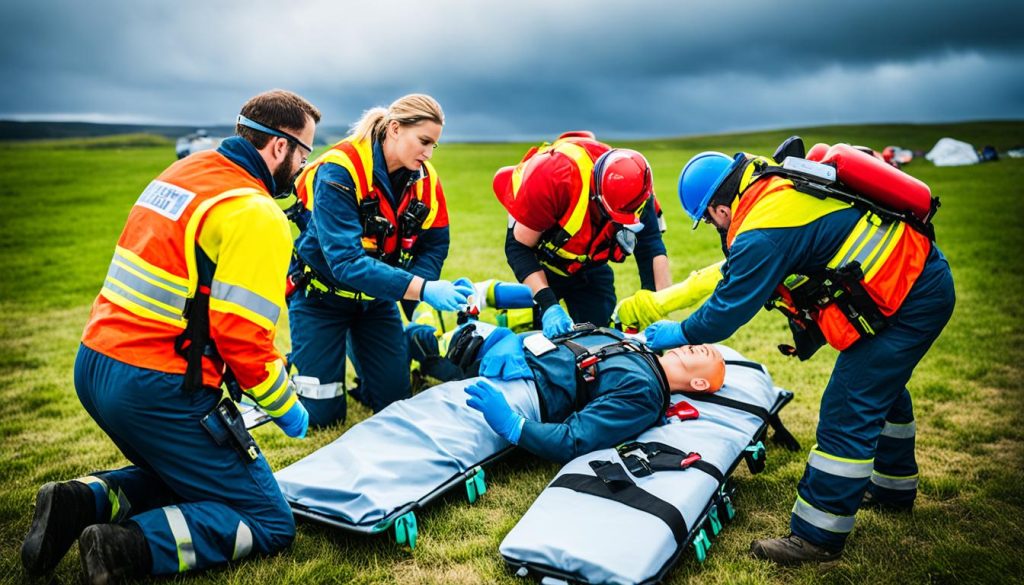Emergency response training and crisis management are keys to workplace safety. They help us deal with the unexpected. Whether it’s a natural disaster or a workplace accident, the right skills save lives.
FEMA stands out, offering top-notch training for first responders and managers. They provide many courses. These help ensure communities can handle emergencies well.
Key Takeaways:
- Emergency response training and crisis management are crucial for workplace safety and preparedness.
- FEMA is the leading provider of training and education for first responders and emergency managers.
- The National Fire Academy focuses on leadership skills and advanced technical training for local fire and emergency services.
- The Center for Domestic Preparedness offers courses on incident management, mass casualty response, and emergency response to natural disasters or terrorist acts.
- The Emergency Management Institute enhances the capabilities of government officials, volunteer organizations, and the public and private sectors in emergency management.
First Responders and Emergency Managers Training
First responders and emergency managers are key in handling crises and emergencies. They get trained to deal with various disasters and help during hard times. FEMA knows how important they are. So, they offer top-notch training and education. This helps them and everyone else be ready for anything.
The NTED and the National Fire Academy train these heroes. They work on different skills like leadership and technical know-how. This training is for those handling fire and emergency services.
The National Fire Academy has many ways to learn. They offer in-person and online classes. They work with local training systems, too. This makes sure everyone can learn, no matter their role or location.
The Center for Domestic Preparedness is also a great place to learn. They teach about managing incidents and responding to disasters or attacks. Their courses are approved by the best training associations.
Thanks to FEMA, these courses are free for the pros and their groups. This removes money worries. So, everyone can get the training they need. This makes them better at their jobs, and we’re all safer for it.
Emergency Management Institute and Consortium Training
The Emergency Management Institute (EMI) is key for training in crisis response. It offers various courses to boost the skills of officials, volunteers, and workers in the public and private sectors. This training helps them lessen the damage caused by disasters. The EMI provides study options that fit different learning styles.
The National Domestic Preparedness Consortium (NDPC) focuses on counter-terrorism training for those who first respond to emergencies. They teach how to deal with dangers from chemical, biological, and other weapons of mass destruction. Thanks to these training programs, these emergency workers can better protect us.
The Rural Domestic Preparedness Consortium (RDPC) also has an important role. It trains emergency workers in rural areas, considering their unique challenges. So, these responders get the exact training they need.
The Center for Homeland Defense and Security (CHDS) helps leaders create policies and strategies to fight terrorism and handle natural disasters. Their programs help leaders continue learning to keep up with threats. This way, they help make the country safer and more prepared.
Benefits of Emergency Management Institute and Consortium Training:
- Enhanced capabilities of government officials, volunteer organizations, and public/private sectors
- Addressing counter-terrorism preparedness needs
- Specialized training tailored to rural emergency responders
- Development of effective policies, strategies, and programs for homeland security
Emergency Management Institute and Consortium Programs
| Program | Description |
|---|---|
| Emergency Management Institute (EMI) | Boosts the skills of government officials, volunteers, and both public and private sector workers to reduce disaster impact. |
| National Domestic Preparedness Consortium (NDPC) | Focuses on counter-terrorism training for emergency responders, highlighting threats from weapons of mass destruction. |
| Rural Domestic Preparedness Consortium (RDPC) | Provides specialized training in homeland security for rural emergency responders, meeting their specific needs. |
| Center for Homeland Defense and Security (CHDS) | Assists in the development of policies and strategies for terrorism and disaster response, enhancing public safety. |
FEMA Higher Education Program and Continuing Training Grants
The FEMA Higher Education Program supports learning and new ideas in handling emergencies. It brings together academics, pros, and doers to solve problems in emergency response and prep. This program keeps the emergency management field up to date and ready for changes.
The program provides Continuing Training Grants (CTG) to push for better emergency readiness in a smart way. These grants help make training that fits the real needs of emergency bosses and first responders. This way, emergency workers get better at their jobs, making our communities safer.
Both the FEMA Higher Education Program and the CTGs are important for making emergency training better. They help keep the whole emergency response community updated and improve our country’s overall readiness.
Table 4: Key Features of FEMA Higher Education Program and Continuing Training Grants
| FEMA Higher Education Program | Continuing Training Grants |
|---|---|
| – Engages academia, professional organizations, and practitioners | – Supports integrated, risk-informed, capabilities-based approach |
| – Fosters continuous learning and innovation | – Addresses urgent and emerging preparedness gaps |
| – Enhances knowledge and skills in emergency management | – Develops and delivers targeted training solutions |
| – Facilitates collaboration and knowledge sharing | – Advances the field of emergency management |
Community Training and Preparedness
Community involvement in emergency preparedness is key. FEMA‘s Individual and Community Preparedness Division (ICPD) helps by developing and providing trainings. These are for volunteers and local organizations. They help support their communities during emergencies.
The OPEN training helps community-based organizations get ready for emergencies. It covers ten steps for preparedness and how to make a disaster response plan.
The You Are the Help Until Help Arrives training is for individuals. It teaches them how to save lives in life-threatening emergencies. This is for when emergency responders cannot get there right away.
The CERT Basic Training teaches CERT members what to do before, during, and after emergencies. It helps them be ready to help their communities effectively.
The CERT Program
The CERT program started in 1985. It became national in 1993. Today, it’s in all 50 states, with participants from tribal nations and U.S. territories. More than 2,700 programs across the U.S. provide emergency preparedness training.
Over 600,000 people have trained with CERT. It gives people skills to respond to disasters. There are also programs for teens, workplaces, and college campuses. This ensures all groups are ready for emergencies.
Disaster Response Skills
During CERT Basic Training, participants learn important disaster response skills. These are essential for managing emergencies. Some of the skills include:
- Fire safety
- Light search and rescue
- Team organization
- Disaster medical operations
By gaining these skills, CERT members can help their communities. They support professional responders during emergencies.
Drills and Leadership Training
CERT programs also hold drills to practice response plans. These drills are like real emergencies. They help CERT members improve their skills and work better together.
There is also leadership training for CERT members in charge. This helps leaders manage CERT teams well during emergencies. It makes the emergency response more organized and efficient.
To wrap up, training and readiness are essential for strong emergency response. Programs like CERT help communities improve their disaster response skills. They empower people and groups to help their communities when needed.
Crisis Management and Disaster Response Courses
These courses help people with important knowledge and skills for emergencies. You’ll learn about managing risks, preparing, and how to respond. They also cover crisis management, giving a full picture of dealing with disasters.
Managers, HSE workers, and others can benefit. It’s good to have some background in risk management. This makes understanding the course even easier.
Joining these classes makes you better at facing emergencies. You learn from real examples and apply these lessons in your work. This means being ready when crisis hits.
“Learning crisis skills helps your job and makes your community safer. You can help protect others by being prepared and making smart choices in emergencies.”
These courses mix theory with hands-on practice. You’ll do group tasks and talk with others. This improves your team and decision-making skills for crisis situations.
Benefits of Crisis Management and Disaster Response Courses:
- Acquire foundational knowledge in emergency management
- Develop an understanding of risk assessment and mitigation strategies
- Enhance crisis communication and decision-making skills
- Foster a proactive approach to emergency preparedness
- Gain insights from real-world case studies and best practices
- Build a strong network of professionals in the field
By taking these courses, you and your group become better at facing dangers. You’ll learn how to handle crises and bounce back quickly. This makes your team strong and ready for anything.
| Course Name | Description | Duration |
|---|---|---|
| Emergency Response Planning | This course teaches how to make detailed plans for emergencies. You’ll learn what standards and rules to follow. | 2 days |
| Disaster Recovery Management | This class is about bringing things back to normal after a disaster. You’ll learn how to recover business operations. | 3 days |
| Crisis Communications | It focuses on talking clearly during a crisis. You gain ways to share important messages with people. | 1 day |
Conclusion
It is vital to have crisis management and emergency response training to keep the workplace safe. These programs teach people what to do before, during, and after a disaster. They help individuals become part of a stronger community ready to act in emergencies.
Studies show that emergency preparedness training works. A 2005 study found that it improved what people knew about readiness and how ready they were to act if needed. Even after a year, knowledge and readiness stayed higher than before the training.
Over 80% of those trained found the methods and materials very helpful and easy to follow. Trained experts used different approaches, like case studies and role-plays, to teach. They also kept checking how well the training worked through surveys and discussions.
Emergency response training is key for everyone’s safety at work. It helps communities and individuals get ready to tackle emergencies. Checking in regularly on how well the training is working makes sure it benefits public health staff and everyone involved.


